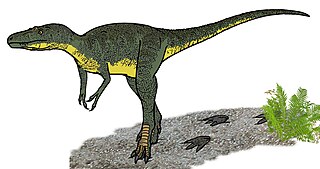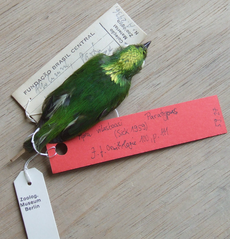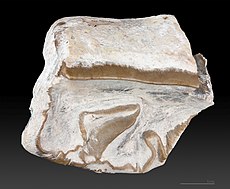Genus is a taxonomic rank used in the biological classification of living and fossil organisms as well as viruses. In the hierarchy of biological classification, genus comes above species and below family. In binomial nomenclature, the genus name forms the first part of the binomial species name for each species within the genus.

The International Code of Zoological Nomenclature (ICZN) is a widely accepted convention in zoology that rules the formal scientific naming of organisms treated as animals. It is also informally known as the ICZN Code, for its publisher, the International Commission on Zoological Nomenclature. The rules principally regulate:

A holotype is a single physical example of an organism used when the species was formally described. It is either the single such physical example or one of several examples, but explicitly designated as the holotype. Under the International Code of Zoological Nomenclature (ICZN), a holotype is one of several kinds of name-bearing types. In the International Code of Nomenclature for algae, fungi, and plants (ICN) and ICZN, the definitions of types are similar in intent but not identical in terminology or underlying concept.

In zoological nomenclature, a type species is the species name with which the name of a genus or subgenus is considered to be permanently taxonomically associated, i.e., the species that contains the biological type specimen. A similar concept is used for suprageneric groups and called a type genus.

In biology, a type is a particular specimen of an organism to which the scientific name of that organism is formally associated. In other words, a type is an example that serves to anchor or centralizes the defining features of that particular taxon. In older usage, a type was a taxon rather than a specimen.

A botanical name is a formal scientific name conforming to the International Code of Nomenclature for algae, fungi, and plants (ICN) and, if it concerns a plant cultigen, the additional cultivar or Group epithets must conform to the International Code of Nomenclature for Cultivated Plants (ICNCP). The code of nomenclature covers "all organisms traditionally treated as algae, fungi, or plants, whether fossil or non-fossil, including blue-green algae (Cyanobacteria), chytrids, oomycetes, slime moulds and photosynthetic protists with their taxonomically related non-photosynthetic groups ."

In binomial nomenclature, a nomen dubium is a scientific name that is of unknown or doubtful application.

In biological nomenclature, a syntype is any one of two or more biological types that is listed in a description of a taxon where no holotype was designated. Precise definitions of this and related terms for types have been established as part of the International Code of Zoological Nomenclature and the International Code of Nomenclature for algae, fungi, and plants.
A tautonym is a scientific name of a species in which both parts of the name have the same spelling, such as Rattus rattus. The first part of the name is the name of the genus and the second part is referred to as the specific epithet in the International Code of Nomenclature for algae, fungi, and plants and the specific name in the International Code of Zoological Nomenclature.
Nomenclature codes or codes of nomenclature are the various rulebooks that govern the naming of living organisms. Standardizing the scientific names of biological organisms allows researchers to discuss findings.
In botany, an infraspecific name is the scientific name for any taxon below the rank of species, i.e. an infraspecific taxon or infraspecies. A "taxon", plural "taxa", is a group of organisms to be given a particular name. The scientific names of botanical taxa are regulated by the International Code of Nomenclature for algae, fungi, and plants (ICN). This specifies a three part name for infraspecific taxa, plus a connecting term to indicate the rank of the name. An example of such a name is Astrophytum myriostigma subvar. glabrum, the name of a subvariety of the species Astrophytum myriostigma.
In zoological nomenclature, author citation is the process in which a person is credited with the creation of the scientific name of a previously unnamed taxon. When citing the author of the scientific name, one must fulfill the formal requirements listed under the International Code of Zoological Nomenclature. According to Article 51.1 of the Code, "The name of the author does not form part of the name of a taxon and its citation is optional, although customary and often advisable." However, recommendation 51A suggests, "The original author and date of a name should be cited at least once in each work dealing with the taxon denoted by that name. This is especially important and has a unique character between homonyms and in identifying species-group names which are not in their native combinations". For the sake of information retrieval, the author citation and year appended to the scientific name, e.g. genus-species-author-year, genus-author-year, family-author-year, etc., is often considered a "de-facto" unique identifier, although this usage may often be imperfect.
In botanical nomenclature, autonyms are automatically created names, as regulated by the International Code of Nomenclature for algae, fungi, and plants that are created for certain subdivisions of genera and species, those that include the type of the genus or species. An autonym might not be mentioned in the publication that creates it as a side-effect. Autonyms "repeat unaltered" the genus name or species epithet of the taxon being subdivided, and no other name for that same subdivision is validly published. For example, Rubus subgenus Eubatus is not validly published, and the subgenus is known as Rubus subgen. Rubus.
The Botanical and Zoological Codes of nomenclature treat the concept of synonymy differently.
In zoological nomenclature, an available name is a scientific name for a taxon of animals that has been published conforming to all the mandatory provisions of the International Code of Zoological Nomenclature for the establishment of a zoological name.

In biology, taxonomic rank is the relative level of a group of organisms in an ancestral or hereditary hierarchy. A common system of biological classification (taxonomy) consists of species, genus, family, order, class, phylum, kingdom, and domain. While older approaches to taxonomic classification were phenomenological, forming groups on the basis of similarities in appearance, organic structure and behaviour, methods based on genetic analysis have opened the road to cladistics.
In zoology, the principle of coordination is one of the guiding principles of the International Code of Zoological Nomenclature.
Under the International Code of Zoological Nomenclature (Code), the name-bearing type is the biological type that determines the application of a name. Each animal taxon regulated by the Code at least potentially has a name-bearing type. The name-bearing type can be either a type genus, type species, or one or more type specimens. For example, the name Mabuya maculata has often been used for the Noronha skink, but because the name-bearing type of the former, a lizard preserved in the Muséum national d'histoire naturelle in Paris, does not represent the same species as the Noronha skink, the name maculata cannot be used for the latter.

This is a list of terms and symbols used in scientific names for organisms, and in describing the names. For proper parts of the names themselves, see List of Latin and Greek words commonly used in systematic names. Note that many of the abbreviations are used with or without a stop.










